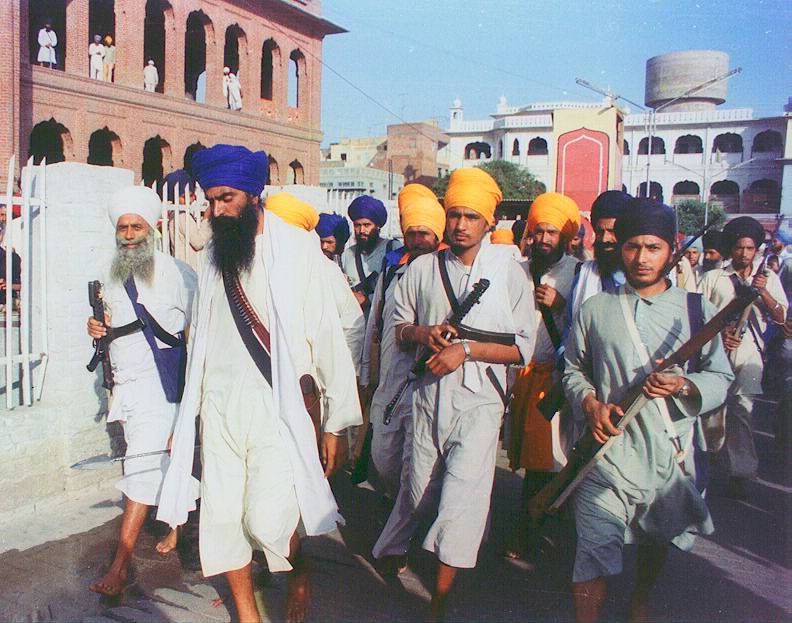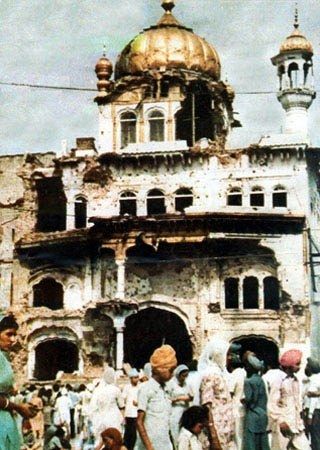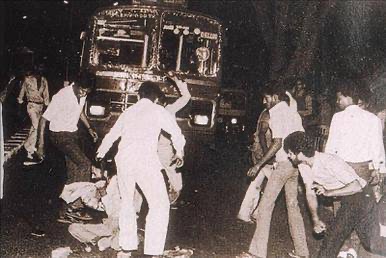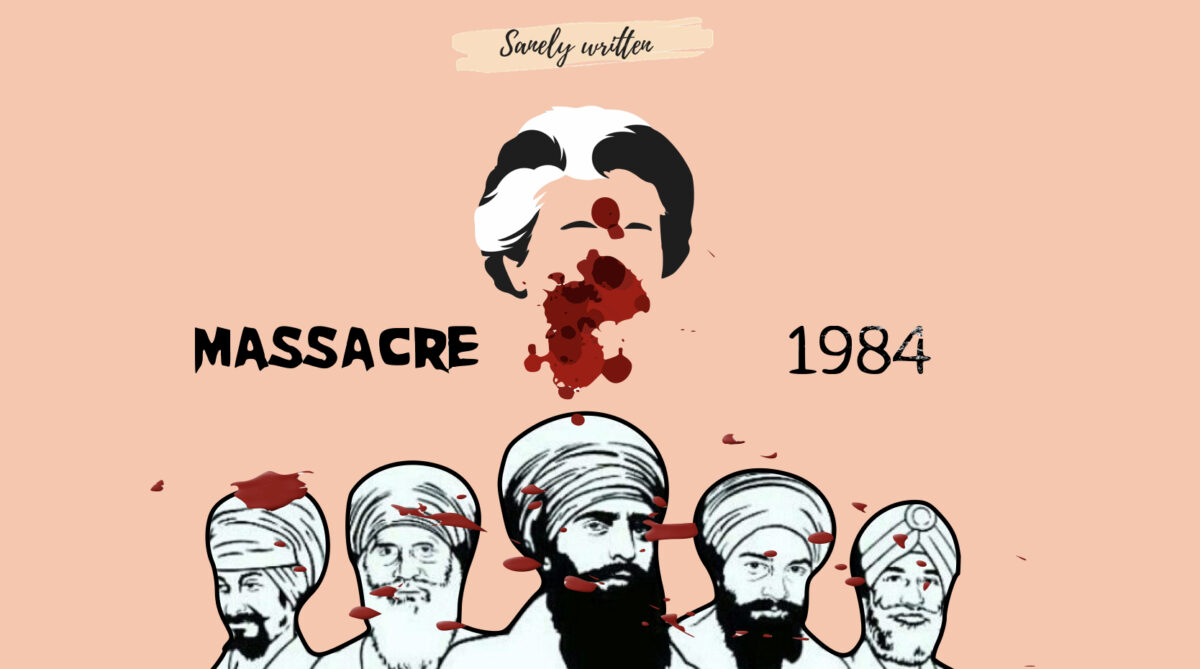The years after 1947 is often termed as the post-independence era. An era filled with new challenges for the new and free India. A country free from colonial rule that faced atrocities and tyranny of the British. But there have been instances when actions of the ‘democratic’ government of India have been no less tyrant than the colonial British rule. One such incident took place in the year 1984 when innocent Sikhs were brutally slaughtered in Delhi, Punjab and also in many regions of the country. Prime minister Indira Gandhi was murdered, the whole country was in a state of turmoil and the aftermath of the “fallen tree” was faced by innocent people. But before getting into the details of the 1984 Sikh Riots, we need to go back to the year 1978, when it all began.
Indian National Congress had lost the General assembly elections in 1977 and the Akali Dal-Janata Party coalition government was formed in Punjab with Prakash Singh Badal as the Chief Minister. To destabilize the coalition government in Punjab, former Chief minister Giani Zail Singh found it suitable to plant the seeds of communalism in Punjab and for that he consulted Sanjay Gandhi, Indira Gandhi’s younger son. Those were the post-emergency years and Sanjay Gandhi was considered as influential and powerful as Indira Gandhi. Zail Singh’s idea was to plant a Sikh Guru as the rival of the government. He thought that if a forceful hard-lined Sikh leader emerges and challenges the Akali Dal leadership for the interest of the minority Sikh community, then the Akali Dal will be forced to have a shift in their policies and any shift in the policies would naturally affect the Janata Party who mainly represented the majority Hindu business interests. Forbidding the congress interests, Sant Jarnail Singh Bhindranwale of Gurudwara Darshan Prakash at Chowk Mehta was chosen. The 1980 parliamentary elections saw Indira Gandhi return to power with a thumping victory and the Congress decided to raise the Bhindranwale-Khalistan issue as their main issue which will portray Indira Gandhi as a strong leader once again which will eventually help them in the 1985 Lok Sabha elections. But little did they know that the Bhindranwale would turn out to be a force to reckon with. The idea of Khalistan was implanted in the minds of the local Sikh population and link that demand to Bhindranwale. The fear of demand of Khalistan by the Sikh community was being planted and Bhindranwale was the monster the people feared. The agenda was to fuel this fear and eventually project Indira Gandhi as the saviour who would fight the ‘monster’ (which she created herself) and come out as a ‘strong leader’.
JARNAIL SINGH BHINDRANWALE AND HIS GROWING INFLUENCE:

Bhindranwale, since his election for the Khalistan project, had started to emerge as a force the government had to tackle. The assembly in Punjab was dissolved and fresh elections were announced in which the Congress returned to power with Darbar Singh as the Chief Minister. Bhindranwale had actively campaigned for the Congress in the elections. His support was so strong that some of the Congress candidates had posters printed out with ‘Bhindranwale supports me’ written on them. With his help, Congress returned to power in Punjab and with the help of the Congress, Bhindranwale had emerged as an influential Sikh political force who was capable to establish and lead a strong Sikh leadership in Punjab. Now Bhindranwale has successfully caught the bait and was unknowingly ready for a much bigger conspiracy.
By this time, the idea of Khalistan was successfully planted in the minds of the Sikh community and they had found a leader in Bhindranwale who would eventually lead them to meet their goal. With the help of the central government, Bhindranwale was growing with a power he had not imagined. His words were considered gospel and the people were blindly following whatever he said. His influence can be figured out by the Gurbachan Singh murder incident. He was murdered in his house in New Delhi and the first name that popped out was Jarnail Singh Bhindranwale. Giani Zail Singh, the then Home Minister, made a statement in parliament that Bhindranwale had nothing to do with the murder of Gurbachan Singh. Another incident is the murder case of Lala Jagat Narain. An FIR was filed against Jarnail Singh and two others for the murder. Chief Minister Darbar Singh sent DIG D.S. Mangat to arrest him. Bhindranwale was tipped off by ‘someone’ and he had travelled to Haryana to escape the arrest but Zail Singh himself phoned Bhajan Lal, Chief Minister of Haryana, to not arrest Bhindranwale and distance himself from this case. Bhindranwale also used to pass through every check post because the officials were instructed directly from the Home minister’s office to let him pass. Congress had his back. Bhindranwale had also constituted a ‘killer squad’ which comprised of deserters from the Punjab police (Amarjit Singh, Sewa Singh, Kabul Singh and Gurnam Singh) who used to dispense a quick justice if any violation of the Sikh religious conduct or if anyone dared challenging the authority of Jarnail Singh Bhindranwale.
THE HOAX OF NEGOTIATIONS AND SFF HELIBORNE COMMANDO OPERATION:
The government needed to be seen doing something about the rising insurgency in Punjab. They needed to be seen taking steps to deal with Bhindranwale and his growing influence. To do so, Indira Gandhi held rounds of negotiations with the Akali leaders headed by Sant Harchand Singh Longowal to come up with a solution. On the other hand, she had the senior officials concerned that if the negotiations did not lead to a fruitful result, she would not hesitate in deploying the elite commando forces, the Special Frontier Force (SFF) as the ‘last resort’. But the negotiations were just a hoax.
Officially, three rounds of negotiations were held between the central government and the Akali leaders, but according to P.C. Alexander, twenty-six rounds of negotiation sessions took place. Strangely, so many rounds of meetings were held but no possible solutions were found out due to the ‘uncooperative, ‘adamant’, ‘incapable’, and ‘powerless’ Akali leaders as stated by the Congress. When a solution was almost on the table and was accepted by both sides, it was sabotaged at the last minute with the intervention of the Chief Ministers of Rajasthan and Punjab as they objected against the worked-out solution. Interestingly, Rajiv Gandhi also headed some rounds of negotiations along with his ‘two very close associates’ despite not being part of the Government or held any significant position.
As the talks were bearing no result, the idea of the heliborne operation was being considered. The situation in Punjab was constantly heating up and the talks were now off the table. To handle the situation, R.N. Kao, the director-general, security (DGS) and the founding secretary of R&AW started contemplating the heliborne operation. The plan was to remove Bhindranwale from the Chowk Mehta Gurudwara and the Golden Temple complex with the help of a heliborne operation conducted by the SFF commando forces of the Indian Army. The British intelligence agency MI6 had also contacted the government and this operation was considered a possible solution that can be carried out with minimum casualties. The blueprint of the operation was ready and it was time now to brief the Prime Minister about the same. DGS R.T. Nagrani along with Kao went to brief Indira Gandhi about the operation where she specifically asked about any possible civilian casualties. After a lot of thought, Nagrani said that there might be a chance that 20 percent of the civilians coming in the way might be killed as the operation was to be conducted on the Baisakhi day celebrations at the Golden Temple complex (April 13). Indira Gandhi killed the operation then and there saying that she cannot afford the civilian casualties. Ironically, Operation Blue Star which was finally carried out as the ‘final solution was a more brutal operation and caused more civilian casualties. There are many papers written on the possible causality analysis if the heliborne operation was conducted and even if the operation did not go according to the plan, the number of possible casualties, in any case, was less than what happened in Operation Blue Star.
It was clear that Indira Gandhi was not looking for a peaceful resort for the Punjab problem and was also ready to have the ‘final solution’. The Objective of appointing Bhindranwale was completed, the Sikh-Hindu divide was achieved, the public was fed up with everything going on in the country and Indira Gandhi was all set to emerge as the saviour. Operation Blue Star began.
OPERATION BLUE STAR:
The Operation was launched on the day of the death anniversary of Guru Arjan Dev when a large number of pilgrims visit the temple. The operation was carried out for almost 9 days but the main army action began on 5th June 1984. By this time most of the Gurudwaras were cleared out with many militants captured or murdered with very few casualties. But after 5th June, the scenario completely changed. The operation was launched at around 10 pm and continued till the morning at 7:30 am. Grenades were thrown from both sides. There are multiple descriptions about the battle, some blaming the army for their brutal assault of ‘innocent’ Sikhs while some blame the militants who were using RPG launchers on the army personnel. But amongst these descriptions, one thing was common and that was the civilians and the pilgrims who died on the field. Some 250 people were trapped inside the main complex temple who were doing the parikrama. Some people also have conflicting views about the library which was burnt that contained copies of Granth Sahib. According to an eye witness of the assault, the pilgrims were captured and taken to the hall where the men were separated and taken to the basement where they were shot. Now to conduct the clearing out operation, SFF commandos, Para commandos and troops of 10 guards were deployed but they were not able to breach through the Akal Takht defences and faced heavy casualties. With no option at his hand, Brigadier Dewan demanded Tank supports.

Source: Outlook India
They received clearance from New Delhi and eight Vijayanta tanks from the 16th Cavalry regiment with 105 mm high explosive squash headshells were deployed and reached the spot around 7 am on 6th June. By the time the operation was over, the Shrine of the Akal Takht was in shambles ( according to the orders, the shrine had to face as minimum damage as possible) and the tanks had fired about eighty shells and the blows were devastating. The army operation was now ending and by the late afternoon on 6th June, the situation was in control. It was the morning of 7th June that the bodies of Jarnail Singh Bhindranwale, Shahbeg Singh, Amrik Singh and Thara Singh were found and the ‘monster’ was finally dead and the news was given to the Prime minister. The bodies of Bhindranwale and others were cremated on 7th June at 7:39 pm and a crowd of about 10,000 had gathered to see it but the army held them back. There are lots of speculations about the postmortem timings, reports, reasons behind the body being badly battered etc.
The Government had published a White Paper in July 1984 which had details about the whole operations. According to that report, the army had lost eighty-three men including 4 officers. The SFF and the para commandos had received the main blows and the guards had also lost twenty men and sixty were injured. There were about 516 civilian casualties and 592 were apprehended. But according to some people and through the postmortem reports received, it was said that around 1200 were killed which was double the amount as per the government records. According to some intelligence estimates and some sources from Satish Jacob of BBC, “… no less than 2000 people were killed including 300 army personnel. Another 800-900 army personnel were injured, many of them crippled for life. If the government had come out with the real figures, it would have shown that the operation was a disaster.” There are many widely conflicting claims about the casualty and I think we would never know about the actual loss of life and property caused due to the disastrous Operation Blue Star. Many cases of mutiny were also found out in different regions of the country. 600 soldiers of the 9th Battalion of the Sikh regiment revolted in Rajasthan. A very large scale mutiny of the Sikh regiment in Bihar where 1461 soldiers stormed the armoury and killed the commandant of the centre Brigadier H.C. Puri.
But the situation in Punjab was a contrast to what was happening in the other parts of the country. The officials had the speculations of a large scale Sikh-Hindu communal hatred in Punjab but the situation was different. Sanjay Suri of the Indian express did a ground report of Punjab on 7th June i.e on the day of Bhindranwale’s death. He went to Rode village at Bhindranwale’s house. There was a large gathering at his house of Sikh people and they were standing quietly. He was the only non-Sikh who went there and experienced the age-old tradition of Punjab of welcoming a guest and making him feel at home. He was offered a place to sit and was served a meal. He thought if this is the treatment a Hindu receives in Jarnail Singh Bhindranwale’s family, and that too on the day of his death, Punjab will be alright. The image of Indira Gandhi as a strong leader was restored but at what cost? The monster that she herself created was killed but at what cost? It was a pyrrhic victory for Indira Gandhi. The hatred amongst the Sikh community for Indira Gandhi was fueling which led to her demise by his own Sikh security Guards Beant Singh and Satwant Singh. R.N Kao had specifically instructed that no Sikh security guard would be appointed in close proximity with the Prime minister but in spite of the strict instructions, Satwant Singh and Beant Singh were placed as her personal security in the morning of 31st October 1984 at the Prime Minister’s residence. The main reason for appointing the two Sikh guards in spite of the clear instructions is still a mystery. Indira Gandhi had speculation that she will be assassinated sooner or later. She had mentioned this thought to Nagrani that she will be killed by some Sikh extremists but that was not her concern and she was more worried about what would happen to her children after that. She also mentioned her death in the famous ‘Khoon ka ek ek katra’ speech in Bhuvneshwar one day before her death on 31st October 1984.
The Sikh Pogrom:

It was clear that Indira Gandhi was murdered because of what she did to the people in Punjab on the pretext of Operation Blue Star. But the consequence of her death was faced by the innocent Sikh population. The Congress party in anger at their leader’s death started picking on innocent Sikh people of Delhi. Riots started taking place in different regions where Sikhs were mercilessly killed. Arjun Das, an associate of Sanjay Gandhi and later Rajiv Gandhi, was manhandling innocent Sikhs on the INA bridge with help of some of his goons and was beating and throwing them off on the railway tracks below the bridge. Such was the fear of Arjun Das that the police did not even interfere with what was happening at INA bridge which was located just 2 km from the PM’s residence and 1 km from the Tughlak Road police station. They were just looking for men with turbans on their head and were simply targeting and killing them. The Defence colonies were also attacked and many Sikh houses were set on fire. G.B.S Sindhu in his book The Khalistan Conspiracy: A former R&AW officer unravels the path to 1984 writes that one of the extremist group was planning to attack a Sikh officer in Satya Marg D-1 flats. Some goons were even carrying a voter’s list in their hands to identify the Sikh people from colonies and some Congress leaders were even supplying them with kerosine oil, car tyres and other ammunitions to kill and burn Sikhs alive. Some men were dragged out of their houses with car tyres around their necks and were burnt alive in the middle of the roads.
P.V. Narasimha Rao was the Home Minister at that time and the Delhi police were reporting everything to him. Vinay Sitapati a journalist and an author revealed in an interview to Focus magazines that he, instead of listening to what the police was reporting him and taking actions accordingly, decided to listen to the Congress which eventually leads to the loss of about 2733 Sikh lives in Delhi. He also telephoned President Zail Singh and instead of reporting him about the happenings in Delhi asked him for a favour to seek assistance for one of his close friend Manmohan Singh (Not Dr Manmohan Singh who later became the Prime Minister) in Kolkata. After the call, the President’s Guards were sent to pick up Manmohan Singh and his family and drop him off at a safe place in Delhi.
Sanjay Suri of the Indian express had covered these incidents extensively and in his book 1984: The Anti Sikh violence and after, he has written about incidents of killings, women rapes and murder, children abduction and many more.
Rajiv Gandhi was given the seat of the Prime Minister after her mother’s death. In a speech at an election rally in New Delhi, he said,” Some riots took place in the country following the death of Indira Ji. We know the people were very angry and for a few days it seemed that India had been shaken but when a mighty tree falls it is only natural that the earth around it does shake a little.” He very easily trivialised the whole incident by calling a it riot and also compared the whole brutal massacre to the aftermath of her mother’s murder. On 9th May 2019, Sam Pitroda the Head of the Indian Overseas Congress in a meeting in Dharamshala, Himachal Pradesh when asked about the whole episode post-Indira Gandhi’s murder said, “Hua to Hua”.
The Congress won the elections again in 1985 and Rajiv Gandhi was elected the Prime minister, now democratically. So the purpose for which Bhindranwale was chosen by Indira Gandhi, to emerge as a strong leader and return congress back to power was served. But the small experiment that she did turn out to be a hazard for her and more hazardous for the Sikhs and the people of Punjab.
CONCLUSION:
There are still lots of minor details that we haven’t covered in this blog regarding Indira Gandhi’s murder and a lot of things regarding the whole episode of Punjab insurgency from 1978 to 1984 that still seem an unresearched conspiracy committed by the Congress party. More than three decades have passed since the massacre of 1984. Yes, they call it riots, we want to call it a massacre. A brutal genocide was happening all around the country and a newly appointed Prime minister, instead of investigating the whole incident, was considering it as an aftershock of his mother’s death. Most of the people seeking justice for their atrocities are dead now and some who are alive, just don’t care now because the time for justice is long gone.
Reference/s:
• The Khalistan Conspiracy: A former R&AW officer unravels the path to 1984 by G.B.S. Sindhu
• Amritsar: Mrs Gandhi’s last battle by Mark Tully and Satish Jacob
• Post-conflict justice in divided democracies: the 1984 anti-Sikh riots in India by Renee Jeffrey & Ian Hall




6 replies on “Massacre 1984”
The Congress needs to come out in the open about it and apologize for what they did to the people of Punjab and to the country
❤️👍🏾
A much needed content…
Well done…👍
Nicely written 👍🏻
Amazing Blogs
Truth,facts and yes,we will call it a massacre!!!